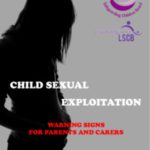What is it?
Child sexual exploitation is a form of abuse, which is helpful to think of a course of conduct rather than an isolated incident as it involves a ‘relationship’. However the relationship is based on a deliberate imbalance of power.
The relationship can take several forms and can follow a pattern:
- Befriending – where contact is made with a child/young person and then the initial contact introduces the child/young person to one or more older men who pose as friends, cousins, relatives of the initial contact. In this stage the child/young person is groomed into a situation which they come to think is ok but is actually harmful to them. Gifts, alcohol, cigarettes etc can be bestowed upon them. In this stage the child/young person may interpret the behaviour demonstrated towards them by an individual as ‘love’.
- Control – in this stage the abuser expects a return on the gifts they have bestowed and will involve sexual favours and the abuser will make threats to gain control over the child/young person. This may involve threats of violence, threats to family members, photographing the child/young person performing sexual activities and threatening to publicise them, involving the child/young person in criminal activities and threatening to report them to the police.
- Exploitation – in this stage the abuser builds the alienation the child/young person can experience, distancing them from friends, parents and other support. This leads the child/young person further into the abuse. In this phase the exploitation includes the child earning money to support their need/pay back the gifts and pay back the perpetrators of the abuse.
The child/young person will be significantly affected by this and may not recognise what is happening to them as abuse, or may feel that it is their fault.
Points of contact can be home, school, shopping centres, entertainment arcades, leisure clubs, taxi ranks, bus and train stations and online.

